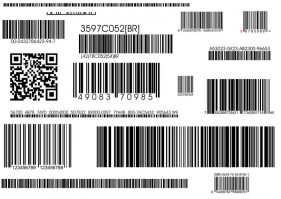8 tips for successful asset labelling
8 tips for successful asset labelling
Let’s look at eight ways to make your asset labelling a success so that you can build a future proof way of asset identification.
1. What assets do I need to keep track of?
Does everything need to be labelled? Work through from the most valuable and at risk items such as cameras and computers before moving down to air conditioning units or furniture. Prioritise the highest value, most at risk items.
2. What type of asset labelling do I use?

If your assets are not subject to weather or wear and tear then a paper label may do the job. However, if it’s likely to be rubbed or spend any time outdoors in the sun or rain, then a waterproof, scratch-resistant label is essential. Scratch resistant label materials start with plastic and move on up to etched aluminium tags. A metal tag can cost £1 each, so you need to be sure that the benefit you’ll get from tracking these assets is worth the investment.
3. What do I print on my labels?
Once you’ve decided on the label you’re using, decide what gets printed on it. Asset labels, at the very minimum, need an identification code which you can trace back to a list of assets. If you’re printing labels you’d be wasting a big opportunity if you didn’t include a barcode. Barcodes will speed up the process of managing your assets and improve accuracy.
4. What barcode should I use?
 Traditional 1D barcodes (which are what you see on groceries) are a first start. 1D codes are like a numberplate on a car. A car registration plate tells you nothing about the car it simply refers you back to database which stores the information. Using a 1D barcode provides a fast way of scanning a code which you use to refer back to your list, but a 2D code is much more powerful.
Traditional 1D barcodes (which are what you see on groceries) are a first start. 1D codes are like a numberplate on a car. A car registration plate tells you nothing about the car it simply refers you back to database which stores the information. Using a 1D barcode provides a fast way of scanning a code which you use to refer back to your list, but a 2D code is much more powerful.
2D codes fall into couple of categories– the QR code which is very flexible and can be read by any smartphone with the proper app installed.
Other 2D codes have increased security and may be smaller in size than a QR code.
5. Should I use a 1D code or a 2D code on my assets?
Where 2-D codes are useful is where you want to store information about the asset on the label. Using a 2D barcode you can store paragraphs of information about an asset – it’s make and model, serial number, date of purchase, purchase cost etc. If your assets are located in rural settings without guaranteed mobile phone coverage this can be a useful for engineers to access important (but limited) information about the asset they are working on.
However there are more benefits to be had where you have mobile phone coverage. 2D codes can encode a URL so you can scan your code, go to an asset webpage and see all the asset information you need. You’re able to share and update asset information on site. You can record information such as who serviced it, when it was serviced and what was done to it.
6. Where do I locate the label on my asset?
Labels are affected by the weather and handling. Whilst labels are available that can last more than 10 years, they are more expensive. If at all possible locate your label on your assets in such a place that’s not in bright sunlight. Sunlight is the biggest cause of damage to your labels outdoors.
Secondly, with electronic device assets such as cameras, handheld scanners or laptop computers, the biggest cause of damage to these labels is wear and tear. Constant handling will damage the barcodes and rub off the text. The challenge now is to put the label in such a place that will not be touched, but is accessible enough to be able to read. Over laminate film, that resembles Sellotape, can do a good job protecting labels from abrasion – ask us about it. Remember; it’s not necessarily hands damaging the label, it’s putting the asset into it’s case which could damage it.
7. Test, and test again.
Pilot your asset labelling system before you put labels on everything. Test how well the labels remain attached and readable. Test that the barcodes are able to deliver the information you need them to.
8. Where do I get asset labels?
You’re in the right place. We can provide you with samples of all kinds of label materials for testing. We can advise on which handheld barcode terminals or software would be best to read your assets with and we are able to print the labels for you or provide the printer and software you’ll need. Contact us and take the first step to tracking your valuable assets.
Finally, asset labelling is the easy bit. Getting everyone to follow the new system is the difficult bit. If you’d like help with implementing your asset tracking system – email us at info@expertlabels.co.uk. We’ve set up asset management systems all around the world and would love to help.
Useful Links
If you need to print your own labels – read our intro to thermal printers page.
Help to decide: print your own or pre-printed labels



